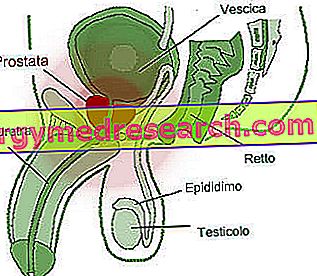Among the most common and unpleasant male disorders, prostate infections play a major role. These infectious processes affect the prostate, an organ roughly the size of a walnut used for the synthesis of prostatic fluid, therefore used for reproductive function.
Prostate and prostatitis infections

In most cases, inflammation of the prostate is of bacterial origin. In other men prostatitis arises from etiopathological elements of another nature: it is the case of abactic or idiopathic prostatitis, an inflammatory process of the prostate with an unknown aetiology, and prostatodynia, a prostatic pain dislodged by inflammation, a (presumed) consequence of a marked pelvic floor tension and urethral spasms.
In the latter two cases, the term "infection" is used improperly, since prostatic pain is independent of a bacterial or pathogenic attack; however, most people tend to talk indiscriminately about "prostatic infection" to describe the pain and burning in situ.
Let us now try to analyze the subject more thoroughly.
Incidence
Prostate inflammation is a very common condition, much more than one could imagine; to give an idea about the diffusion of the disturbance, below are some indicative data:
- 2-10% of men: this slice of the population seems to complain about all the symptoms referable (at least presumably) to a chronic prostatic infection
- 15% of men: they suffer from prostatic infections with mild symptoms (level 1)
- 25% of patients suffering from genitourinary disorders also suffer from prostate inflammation: of these, only 5-10% depends on bacterial insults
Causes
Prostate infection is often an expression of irritation and swelling that follows a bacterial insult: pathogenic microorganisms, after ascending the urethra, are able to localize themselves to the prostate level, and here proliferate. The mechanism of ascending contamination described above is the most immediate consequence of unprotected sexual relations with risky partners: for this reason, it is recommended to always use barrier contraceptive methods (eg condoms) before consuming a relationship with people at risk.
However, the propagation of bacteria can also take place in another way: pathogenic bacteria located at a rectal level, reproducing and spreading directly or lymphatically, can reach the prostate and cause inflammation and infection.
Moreover, it should not be forgotten that prostatic infections can be a complication of urethral or bladder infections: in these cases, pathogens can spread through the bloodstream.
The pathogenic microorganisms most involved in prostate infections are:
- Neisseria gonorrhea
- Chlamydia trachomatis
- Escherichia coli
- Enterobacter aerogenes
- Serratia marcescens
- Pseudomonas aeruginosa
- Proteus mirabilis
Prostate infections are more common in some men than in others: the immunocompromised and subjects with nervous system disorders seem to be more at risk. Among the other predisposing factors, we mention: AIDS, urinary catheter, dehydration, adult / senile age, mildly enlarged prostate gland (benign prostatic hypertrophy), genetic predisposition, regressive history of prostatic infections, stress and pelvic trauma.
Symptoms
The symptoms that characterize prostate infections vary depending on the causative agent involved in the insult; for the same reason, the intensity of the prodrome is also heavily influenced by the pathogen, as well as by the patient's general health and age. The symptoms common to the vast majority of prostatic infections are: arthralgia, difficulty urinating, dysuria (pain / burning during urination), abdominal pain, pain limited to the area between the scrotum and rectum, groin pain, painful ejaculation, inguinal lymphadenopathy, lumbago, myalgia, urgent need to urinate, nocturia and blood loss with urine. Sometimes, patients suffering from acute bacterial prostatitis also complain of flu-like disorders (chills, fever, nausea and vomiting), the result of the sudden attack of bacteria.
In addition to the symptoms listed above, prostate infections can be characterized by an enlargement, mild or more marked, of the prostate gland, which on palpation (medical) is soft, warm, with a nodular consistency. When prostate infections are neglected, the risk of complications increases; epididymitis, orchitis, erectile dysfunction and bacteremia are the most common complications.
Diagnosis
Early diagnosis is the ideal premise for minimizing the risk of complications: in fact, it is important to seek medical attention from the very first symptoms, without hesitating or delaying. The doctor, before visiting the patient, inquires about symptoms and general state of health by examining what the patient reports. Subsequently, the physical examination involves the visit of the genitals, the palpation of the abdomen and the digital rectal investigation, essential to establish the conditions of the prostate (inflammation, consistency etc.). To ascertain bacterial infection, a microbiological blood test is useful; also the sperm and urine test is one of the most frequent diagnostic tests in case of alleged prostate infection.
Among other medical tests, cystoscopy should not be forgotten, for examining the urethra and bladder; in the case of prostatic infection associated with marked urinary difficulties, it is recommended to undergo urodynamic testing, to understand whether the difficulty in urinating actually depends on the infection or not.
Prevent prostate infections
Is it possible to prevent prostate infections? Prostate infections can be prevented by putting simple tricks in practice: first of all, especially for males no longer young, it is recommended to follow a regular and balanced diet, free from excesses. The excesses, however, just like the renunciations, should also be avoided as regards the sexual sphere, since the prostate also controls the reproductive function.
Even constipation could constitute, albeit indirectly, a risk factor for prostatic infections, due to the bacteria that remain "trapped" in the body for a long time: therefore, here is that following a balanced diet, rich in fiber and, eventually, integration with specific laxative products (to be taken only when necessary) is useful to avoid prolonged episodes of constipation.
Even physical exercise, however important in everyone's life, must be exercised with particular caution by patients most at risk of prostate infections; these subjects should avoid all those sports actions that stress the prostate (eg cycling, horse riding, motorcycling, etc.).
Medications and treatments
Since bacteria are responsible for prostatic infections, the antibiotic therapy is the chosen therapy: antibiotic drugs exert their therapeutic activity excellently, especially in acute forms. Different discourse must be addressed for chronic variants: prostatic infections that have lasted longer are more complex to remove, given that the bacteria are more resistant to antibiotics. Antibiotic therapy should normally be continued for 14-21 days for acute forms and for 3-5 months for chronic variants; the antibiotic drugs belonging to the class of quinolones and cephalosporins are certainly the most indicated to eradicate prostate infections.
For further information: read the article on drugs for the treatment of prostatitis



